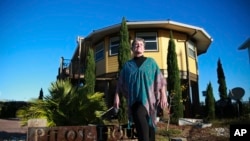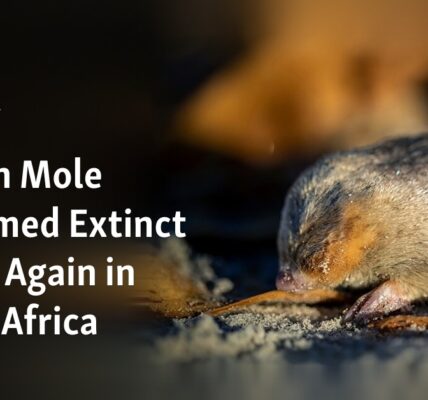Five years ago, the Florida Panhandle was struck by Hurricane Michael, causing significant damage to the small coastal town of Mexico Beach. Bonny Paulson’s home, which sits on pillars 14 feet above ground, was surrounded by boats, cars, and trucks piled up to the windows. Despite its unique rounded shape resembling a ship, Paulson’s home was able to withstand the Category 5 winds that could have potentially caused it to collapse.
“I was completely calm,” Paulson stated, reflecting on the evacuation order. Despite the severe damage to the surrounding homes, her house only lost a few shingles, as seen in photos taken after the storm.
Several developers are constructing houses, inspired by Paulson’s, with the goal of making them stronger against the rising intensity of extreme weather due to climate change. Additionally, these homes are designed to be more environmentally friendly. For instance, solar panels are installed tightly enough to prevent wind damage and provide clean energy even during a storm. The incorporation of preserved wetlands and native plants also helps trap carbon in the soil and decreases susceptibility to flooding. Furthermore, the use of recycled or innovative building materials not only reduces energy consumption but also minimizes the need for new materials.
The actions taken by an individual in their own home can greatly impact their carbon footprint. Approximately 38% of annual greenhouse gas emissions are attributed to buildings. These emissions are a result of energy consumption, such as from lighting and air conditioning, as well as the production of construction materials like concrete and steel.
According to Deltec, the firm responsible for constructing Paulson’s residence, only one out of the approximately 1,400 homes they have built in the past 30 years has experienced structural harm from strong hurricanes. Additionally, the company prioritizes eco-friendly building practices by utilizing superior insulation to minimize the reliance on air conditioning, installing heat pumps for more effective temperature control, using energy-saving appliances, and incorporating solar technology.
“The true brilliance lies in our ability to achieve both,” stated CEO Steve Linton. “Often, resilience is an afterthought in discussions about sustainable construction, treated as just another feature on a checklist. However, we firmly believe that resilience is a crucial aspect of sustainability.”
Some businesses are constructing entire communities that are capable of withstanding hurricanes and also have a lower impact on climate change compared to the average.
The Mirabella community, located in Bradenton, Florida and developed by Pearl Homes, is comprised of 160 houses that have all received platinum LEED certification. This is the top tier of one of the most commonly used green building rating systems.
In order to minimize the risk of flooding, home sites are elevated by 3 feet according to building regulations. Similarly, roads are also elevated and constructed to divert excess rainwater away from the area and onto absorbent ground. The homes feature steel roofs with tightly sealed seams, making it challenging for strong winds to penetrate underneath. Additionally, the houses are equipped with batteries that activate in case of power outages.
Marshall Gobuty, CEO of Pearl Homes, shared that his group proposed a community project to the University of Central Florida with the goal of creating a sustainable and climate-friendly environment. Gobuty emphasized the importance of not only being sustainable but also resilient, and wanted the community to stand out from the typical construction in Florida. He expressed concern about the current state of the weather and its impact on newly built homes in the area.
Paulson, a resident of Mexico Beach, relates to that sentiment and expresses her aversion to constantly worrying about potential Atlantic storms. In addition to feeling more at ease, she is pleased with her current energy bill of $32 per month, a significant decrease from the $250 she used to pay in her previous residence.
She expressed her concern that the population is not acknowledging the impact of environmental disasters and making necessary changes. She also noted that we are continuing to construct the same structures that have been destroyed in the past.
Babcock Ranch, located in South Florida, is a sustainable and hurricane-proof community. It proudly boasts the title of the first solar-powered town in the United States, producing 150 megawatts of electricity through 680,000 panels spread across 870 acres. This community was also among the pioneers in the country to have significant battery storage on site, allowing for the utilization of excess solar power during nighttime or power outages.
In 2006, Syd Kitson established Babcock Ranch. The houses are designed to be resilient against hurricane winds by securing the roofs to a foundation-linked system. Additionally, the power lines are placed underground to prevent them from toppling over. Some homes have outward-swinging doors to prevent them from forcefully opening due to wind pressure, and garage vents help equalize the air pressure.
Hurricane Ian, a Category 4 storm, passed through Babcock Ranch in 2022 with minimal impact, according to Kitson.
“We aimed to demonstrate that a new community and its surroundings can coexist effectively, and I believe we have achieved that,” stated Kitson. “Unless you construct in a highly durable manner, you will continually be faced with repairs or the need to demolish homes.”
The company sold 73,000 acres of its property to the state for the purpose of preserving wetlands. The team also examined the natural water flow in the surrounding area and integrated it into their water management system on the site.
According to Kitson, water will always flow where it wants to, and attempting to defy Mother Nature will result in defeat every time. However, the presence of wetlands, retention ponds, and natural plant life can effectively control water during heavy rainfall, minimizing the chances of homes being flooded.
Natalia Padalino and her husband, Alan Klingler, intend to complete the construction of a Deltec residence in the Florida Keys before December. The couple was worried about the potential effects of global warming and hurricanes on the area and looked into homes that were environmentally-friendly and resilient against severe weather conditions.
Klingler stated that they are creating a project that will be a great investment and lower the chances of a major disaster.
“People have been very welcoming and willing to stay at our place if a hurricane occurs,” Padalino stated.
Source: voanews.com





